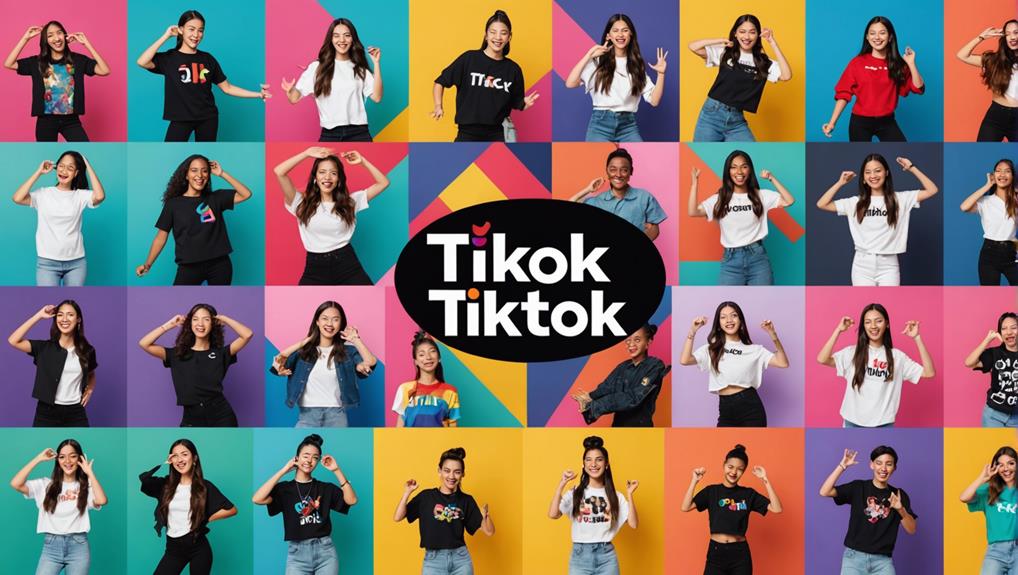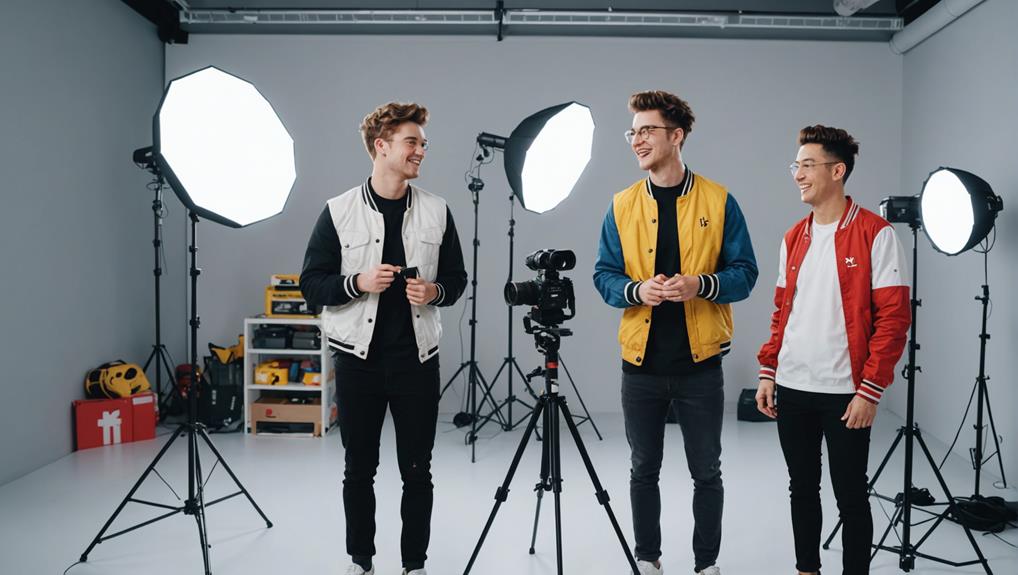Effective TikTok influencer collaborations should be guided by strategic audience alignment, ensuring influencer demographics match your target market. Leverage creative synergy by offering influencers creative freedom while aligning with campaign goals. Data-driven insights facilitate real-time adjustments, boosting engagement and return on investment. Culturally resonant content, using relevant topics and emotional storytelling, maximizes connection with Gen Z audiences. Innovative engagement techniques like hashtag challenges and live sessions enhance brand visibility and consumer interaction. These strategies help businesses create meaningful and impactful collaborations, positioning themselves for success in TikTok’s dynamic environment. Explore further to reveal deeper insights for your campaigns.
Key Takeaways
- Select influencers with demographics aligning with your target market, focusing on TikTok users under 35.
- Allow creative freedom within structured guidelines to balance brand messaging and influencer creativity.
- Use data insights for real-time optimization, enhancing engagement rates and campaign ROI.
- Collaborate with culturally relevant influencers to deepen emotional connections and drive engagement.
- Encourage user-generated content through hashtag challenges and TikTok Live sessions to expand brand reach.
Influencer Selection Criteria
In the rapidly evolving landscape of TikTok marketing, selecting the right influencers is vital to achieving brand success. Prioritizing TikTok influencers whose audience demographics align with your target market is fundamental, especially considering that over 60% of TikTok users are under 35. This demographic alignment guarantees that influencers can effectively bridge your brand to the interests of potential consumers.
Utilizing the TikTok Creator Marketplace provides access to a vast database of over 14,000 vetted creators, streamlining the search and communication processes. This platform allows brands to filter by specific categories, ensuring that influencers’ follower count and content quality meet your criteria.
Evaluating engagement metrics, such as likes, comments, and shares, is essential in determining an influencer’s effectiveness. High engagement rates often indicate authentic connections with the audience, reducing the likelihood of brand misalignment. Conducting thorough background checks on influencers further guarantees that their past content and brand associations resonate with your brand values.
Additionally, considering nano influencers, who boast an engagement rate of 11.97%, can be advantageous. These influencers, with 1,000-10,000 followers, often provide high interaction levels, fostering genuine and impactful brand-consumer relationships. This strategic selection process enhances the potential for successful collaborations.
Aligning Creativity and Goals
Balancing creative vision with strategic business objectives is an essential component in successful TikTok influencer collaborations. In the sphere of TikTok influencer marketing, aligning creativity and goals is imperative for crafting campaigns that resonate with audiences and drive results.
Campaigns that allow influencers to exercise creative freedom while adhering to brand values typically achieve superior audience engagement, evidenced by a 19% greater predicted sales effect compared to standard benchmarks.
To achieve this balance, businesses must establish clear campaign objectives, ensuring influencers understand targeted outcomes and audience demographics. This understanding empowers influencers to produce tailored content that aligns with both the brand’s message and their personal style, fostering authentic content creation.
Such influencer partnerships are grounded in structured guidelines that define key messages and campaign hashtags, yet maintain the flexibility for creative expression.
Effective collaboration strategies also hinge on ongoing communication and feedback, enabling adjustments that keep creative outputs aligned with evolving business objectives and audience preferences.
As campaigns progress, utilizing performance metrics can further refine approaches, ensuring influencer partnerships remain adaptive and effective. This strategic alignment ultimately enhances the impact of TikTok influencer marketing, driving engagement and achieving desired business goals.
Leveraging Data Insights
As the digital landscape evolves, leveraging data insights becomes essential for optimizing TikTok influencer collaborations. In TikTok influencer marketing, data-driven strategies are pivotal in identifying content that resonates with target audiences, enhancing engagement rates and ROI. Brands utilizing analytics report notable increases in brand loyalty, underscoring the role of data insights in achieving long-term success.
Continuous optimization based on performance metrics allows real-time strategic adjustments, ensuring campaigns remain relevant. For instance, TikTok creator ads informed by data insights show a 19% greater predicted sales effect than benchmarks, highlighting data’s impact on sales outcomes. This approach not only bolsters engagement but also drives tangible business results.
Effective measurement through conversion tracking and promo codes enables brands to assess success accurately. Key metrics such as engagement rates and impressions provide a thorough view of campaign effectiveness.
| Metric | Purpose |
|---|---|
| Engagement Rates | Evaluate audience interaction |
| Performance Metrics | Monitor campaign effectiveness and ROI |
| Conversion Tracking | Measure sales and action-driven outcomes |
To maintain a competitive edge, brands must integrate continuous optimization into their strategies, using data insights to sustain and enhance campaign effectiveness across TikTok influencer marketing initiatives.
Cultural and Emotional Impact
Harnessing data insights is a powerful tool, yet the cultural and emotional dimensions of TikTok influencer marketing offer a distinct avenue for creating impactful connections.
Cultural relevance is paramount, as it drives consumer engagement by aligning with trending topics and shared cultural moments. This guarantees that campaigns resonate deeply, fostering emotional ties with target audiences. TikTok creators, viewed by 74% of Gen Z as trustworthy, leverage influencer authenticity to craft relatable content that effectively captures emotional intelligence.
Emotional marketing shines in this landscape, as campaigns that tap into consumer emotions with empathetic storytelling outperform traditional methods. This approach not only differentiates brands but also cultivates enduring brand loyalty and trust. The collaboration with cultural icons enhances this strategy, amplifying brand visibility and fostering deeper emotional connections.
- Relatable Content: Engaging content that mirrors cultural relevance and emotional intelligence strengthens consumer bonds.
- Influencer Authenticity: Authentic narratives from TikTok creators bolster consumer engagement and trust.
- Collaborative Content: Partnerships with TikTok creators and cultural icons enlarge brand impact and emotional resonance.
To harness these elements effectively, brands must align their strategies with the cultural and emotional pulse of their audiences, guaranteeing their campaigns are not just seen, but genuinely felt.
TikTok Engagement Techniques
To effectively engage audiences on TikTok, brands must employ innovative techniques that align with the platform’s dynamic nature and user expectations. A successful TikTok influencer campaign can greatly enhance brand awareness by leveraging high engagement rates.
Utilizing TikTok’s hashtag challenges, such as the notable #gymshark66, which amassed 45.5 million views, encourages user participation and generates considerable user-generated content. Such initiatives not only boost visibility but also foster community involvement, an essential aspect of social media marketing.
Engagement is further amplified through creative content creation. Brands collaborating with influencers to create authentic content, like day-in-the-life TikTok videos, seamlessly integrate products into relatable narratives, thereby increasing shares and interactions. This strategy capitalizes on the platform’s algorithm, which favors engaging and authentic content.
Additionally, hosting TikTok Live sessions is a potent tool for real-time interaction, with 50% of users inclined to make purchases post-session, thereby presenting immediate impact opportunities.
Promoting user-generated content is another effective technique. By encouraging followers to share content, brands can expand their reach and reinforce loyalty. This approach leverages TikTok’s inherent social nature, driving community engagement and enhancing brand affinity.
Frequently Asked Questions
How Can Small Businesses Afford Tiktok Influencer Collaborations?
Small businesses can leverage budget-friendly tactics by engaging micro influencers, utilizing creative content strategies, and forming barter agreements. Focus on community engagement, niche targeting, and local collaborations. Implement product seeding, seasonal campaigns, and track performance metrics for success.
What Legal Considerations Are Involved in Influencer Partnerships?
Legal considerations in influencer partnerships encompass contractual agreements, disclosure requirements, intellectual property, content ownership, and audience authenticity. Adhering to FTC guidelines, addressing liability issues, incorporating exclusivity clauses, ensuring brand alignment, and tracking campaign metrics are essential.
How Should Businesses Handle Negative Feedback From Influencer Campaigns?
To effectively manage negative feedback from influencer campaigns, businesses should implement an all-encompassing response strategy emphasizing feedback management, crisis communication, and audience engagement, ensuring influencer transparency, reputation recovery, proactive outreach, feedback monitoring, and maintaining brand authenticity in customer relations.
What Are the Best Practices for Compensating Tiktok Influencers?
Fair compensation involves tiered payments reflecting influencer reach, with performance bonuses for high audience engagement. Consider product swaps and long-term partnerships for niche targeting. Guarantee transparent communication, content ownership, and brand alignment to foster effective collaborations.
How Do Businesses Ensure Compliance With Tiktok’s Advertising Policies?
Businesses guarantee compliance with TikTok’s advertising policies by adopting compliance strategies that emphasize ethical practices, brand safety, and transparency requirements. They must align with influencer guidelines, adhere to content restrictions, and respect platform regulations while optimizing audience targeting.
Conclusion
In summary, businesses seeking to optimize TikTok influencer collaborations must strategically select influencers who align with their brand values and audience. Creativity should be harmonized with business goals to guarantee authentic content delivery. Leveraging data insights is essential for measuring campaign effectiveness and refining strategies. Additionally, understanding the cultural and emotional resonance of content can enhance brand connection. Employing advanced TikTok engagement techniques can further maximize reach and impact, positioning businesses for greater success in the dynamic digital landscape.




